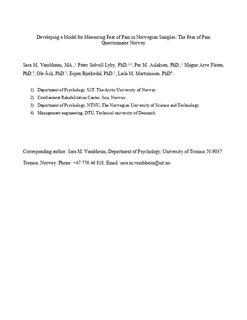| dc.contributor.author | Vambheim, Sara Magelssen | |
| dc.contributor.author | Lyby, Peter Solvoll | |
| dc.contributor.author | Aslaksen, Per M | |
| dc.contributor.author | Flaten, Magne | |
| dc.contributor.author | Åsli, Ole | |
| dc.contributor.author | Bjørkedal, Espen | |
| dc.contributor.author | Martinussen, Laila Marianne | |
| dc.date.accessioned | 2019-05-20T10:43:02Z | |
| dc.date.available | 2019-05-20T10:43:02Z | |
| dc.date.created | 2017-11-10T15:27:43Z | |
| dc.date.issued | 2017 | |
| dc.identifier.citation | Scandinavian Journal of Pain. 2017, 17 425-430. | nb_NO |
| dc.identifier.issn | 1877-8860 | |
| dc.identifier.uri | http://hdl.handle.net/11250/2598006 | |
| dc.description.abstract | Background
Fear of pain is highly correlated with pain report and physiological measures of arousal when pain is inflicted. The Fear of Pain Questionnaire III (FPQ-III) and The Fear of Pain Questionnaire Short Form (FPQ-SF) are self-report inventories developed for assessment of fear of pain (FOP). A previous study assessed the fit of the FPQ-III and the FPQ-SF in a Norwegian non-clinical sample and proved poor fit of both models. This inspired the idea of testing the possibility of a Norwegian FOP-model.
Aims and methods
A Norwegian FOP-model was examined by Exploratory Factor Analysis (EFA) in a sample of 1112 healthy volunteers. Then, the model fit of the FPQ-III, FPQ-SF and the Norwegian FOP-model (FPQ-NOR) were compared by Confirmatory Factor Analysis ( CFA). Sex neutrality was explored by examining model fit, validity and reliability of the 3 models amongst male and female subgroups.
Results
The EFA suggested either a 4-, a 5- or a 6-factor Norwegian FOP model. The eigenvalue criterion supported the suggested 6-factor model, which also explained most of the variance and was most interpretable. A CFA confirmed that the 6-factor model was better than the two 4- and 5-factor models. Furthermore, the CFA used to test the fit of the FPQ-NOR, the FPQ-III and the FPQ-SF showed that the FPQ-NOR had the best fit of the 3 models, both in the whole sample and in sex sub-groups.
Conclusions
A 6-factor model for explaining and measuring FOP in Norwegian samples was identified and termed the FPQ-NOR. This new model constituted six factors and 27 items, conceptualized as Minor, Severe, Injection, Fracture, Dental, and Cut Pain. The FPQ-NOR had the best fit overall and in male- and female subgroups, probably due to cross-cultural differences in FOP.
Implications
This study highlights the importance on exploratory analysis of FOP-instruments when applied to different countries or cultures. As the FPQ-III is widely used in both research and clinical settings, it is important to ensure that the models construct validity is high. Country specific validation of FOP in both clinical and non-clinical samples is recommended. | nb_NO |
| dc.language.iso | eng | nb_NO |
| dc.publisher | De Gryuter | nb_NO |
| dc.title | Developing a model for measuring fear of pain in Norwegian samples: The Fear of Pain Questionnaire Norway | nb_NO |
| dc.type | Journal article | nb_NO |
| dc.type | Peer reviewed | nb_NO |
| dc.description.version | acceptedVersion | nb_NO |
| dc.source.pagenumber | 425-430 | nb_NO |
| dc.source.volume | 17 | nb_NO |
| dc.source.journal | Scandinavian Journal of Pain | nb_NO |
| dc.identifier.doi | 10.1016/j.sjpain.2017.10.009 | |
| dc.identifier.cristin | 1513084 | |
| dc.description.localcode | This article has been published in a revised form in [Scandinavian Journal of Pain ] [https://doi.org/10.1016/j.sjpain.2017.10.009]. This version is free to view and download for private research and study only. Not for re-distribution, re-sale or use in derivative works. | nb_NO |
| cristin.unitcode | 194,67,40,0 | |
| cristin.unitname | Institutt for psykologi | |
| cristin.ispublished | false | |
| cristin.fulltext | original | |
| cristin.qualitycode | 1 | |
